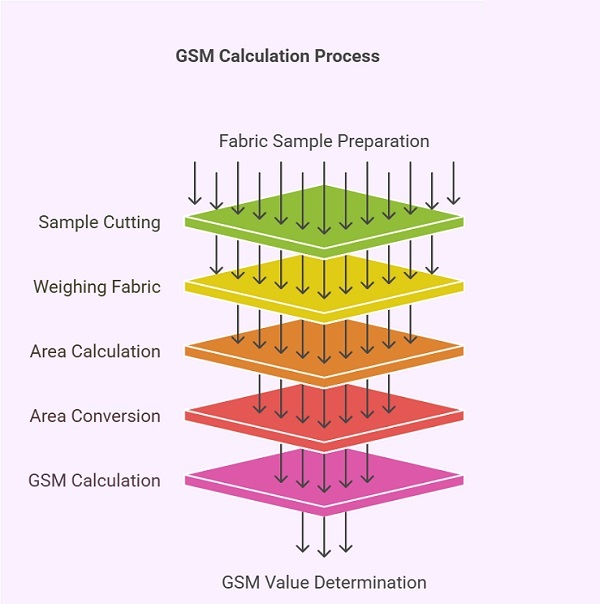GSM Calculation
© Yarn Count Ltd
Disclaimer: All tools in the Yarn Count have been reviewed by the relevant spinning industry experts.
GSM Calculation Formula:
GSM = (Weight of the fabric sample (grams) × 10,000) ÷ Area of the fabric sample (cm2)
Where:
- GSM = Grams per Square Meter
- Weight of the fabric sample = Measured in grams
- Area of the fabric sample = Usually taken in square centimeters (cm2cm^2)
- 10,000 = Conversion factor to scale from cm2cm^2 to m2m^2
Table of Contents
What is GSM in Textiles?
GSM (Grams per Square Meter) is a crucial measurement used in the textile industry to determine the weight of fabric. It directly influences the fabric's thickness, durability, and overall quality. Whether you are a textile engineer or involved in textile production, understanding GSM calculation is vital for ensuring the right fabric specifications for various applications.
GSM refers to the weight of the fabric in grams per square meter. It is a standard measurement used to assess fabric weight, particularly for woven and knitted fabrics. GSM helps determine fabric density, which affects its strength, feel, and suitability for different uses. Fabrics with higher GSM are typically heavier and more durable, while those with lower GSM are lighter and often used for delicate garments or summer wear.

Importance of GSM in Textile Manufacturing
The GSM value plays a significant role in textile production. It impacts several factors, including:
- Fabric Quality: Higher GSM values often indicate thicker, more durable fabric.
- End Use: Lighter fabrics (low GSM) are often used in garments like t-shirts, while heavier fabrics (high GSM) are used for upholstery or outerwear.
- Cost: Higher GSM fabrics require more raw material and are usually more expensive.
Understanding and controlling GSM is essential for meeting product specifications and ensuring that the fabric performs as expected in its intended application.
How to Calculate GSM
Calculating GSM involves measuring the weight of a specific area of fabric and then calculating how much it weighs per square meter. Here’s a step-by-step guide to the GSM calculation process:
Materials Needed:
- Fabric Sample: Cut a small, uniform piece of fabric from the roll or batch.
- Scale: A precision scale to weigh the fabric accurately.
- Ruler: To measure the area of the fabric sample.
Steps for GSM Calculation:
- Cut a Sample: Cut a square piece of fabric, usually measuring 10 cm by 10 cm (or any size, as long as the dimensions are known).
- Weigh the Fabric: Weigh the fabric sample using a precision scale. The weight should be in grams.
- Calculate the Area: Determine the area of the fabric sample. For a square piece, this would be the length times the width. If the sample is 10 cm by 10 cm, the area would be 100 cm².
- Convert to Square Meters: Since GSM is based on square meters, you need to convert the fabric area from cm² to m². (1 m² = 10,000 cm²).
- Calculate GSM: Multiply the weight of the fabric by a conversion factor to adjust for the size of the sample. The formula is:
GSM=(Weight in grams ÷ Area in square meters)
By following these steps, you can determine the GSM of any fabric sample accurately.
Key Conversions in GSM Calculations

Sometimes, it is necessary to convert GSM to other fabric measurements such as yarn count, denier, or tex. Below are the conversion formulas you can use:
GSM to Count Calculator
Yarn count (or yarn number) is a measurement of the thickness or fineness of the yarn used in fabric. You can convert GSM to yarn count using the following formula:
Count (Ne)=(150×GSM ) ÷ Denier or Tex
In this formula:
- Count (Ne): Yarn count in Ne (metric count).
- GSM: Fabric weight in grams per square meter.
- Denier or Tex: Yarn thickness.
GSM to Denier Calculator
Denier is a unit of measure for yarn thickness, often used in synthetic fibers. To convert GSM to Denier, you can use the following formula:
Denier= (GSM×9,000) ÷ Yarn Count (Ne)
This formula helps you convert fabric weight to yarn thickness for specific fabrics.
GSM to Tex Conversion
Tex is another unit used to describe the fineness of yarn. It is calculated based on the weight of the yarn in grams per 1,000 meters. To convert GSM to Tex, use this formula:
Tex=(GSM×Width of the fabric in cm) ÷ 100
This formula helps you understand how fabric weight relates to the fineness of the yarn.
Factors Affecting GSM
While GSM is an essential measurement, several factors influence it, including:
- Fabric Type: Different types of fabrics (woven, knitted, non-woven) will have varying GSM values.
- Fiber Type: Natural fibers like cotton and wool may have different GSM values compared to synthetic fibers like polyester.
- Weave Type: Fabrics with a tight weave will generally have a higher GSM than those with a loose weave.
- Moisture Content: The moisture in fabric can affect its weight, which may alter the GSM value.
Understanding these factors allows textile engineers to control the production process and ensure fabric meets specific requirements.
Conclusion
Calculating GSM is an essential skill for textile professionals, especially for those working in fabric production and quality control. Accurate GSM measurements help ensure the proper fabric weight, durability, and end-use performance. With tools like GSM calculators for Count, Denier, and Tex conversions, textile engineers can streamline the process and achieve the desired fabric specifications efficiently.
By using the simple steps and formulas provided in this article, you can easily calculate GSM and perform essential conversions for various textile applications. Always keep in mind that fabric weight is just one of many factors that affect its quality and suitability for a particular use.